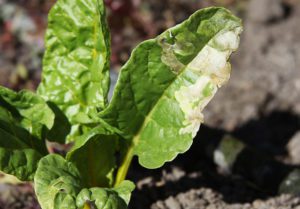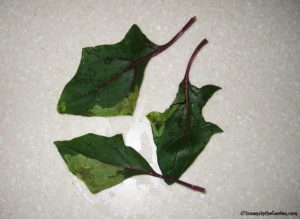Leaf Miners
 Latin names: Liriomyza langei, L. sativae, L. trifolii
Latin names: Liriomyza langei, L. sativae, L. trifolii
Size: Adults are small flies with wings about 1.25 mm in length; larvae are about 2.25 mm long.
Color: Adult flies are black with yellow undersides; larvae are green to yellow in color as they mature.
Life cycle: The adult flies lay small white eggs on the upper surface of a leaf. The eggs hatch in just 3 days, with the larvae going through 3 instar stages. During this time, they feed on the layers of cells within the leaves, causing a great deal of damage. They drop into the soil to pupate for 9 days, at which time they emerge as adults and mate. The adults typically produce many generations during the course of a year.
 Signs of their activity: White squiggly lines and small “windows” (transparent areas, see photo) within leaves.
Signs of their activity: White squiggly lines and small “windows” (transparent areas, see photo) within leaves.
Typically seen on: Spinach, Swiss chard and beet leaves within the vegetable garden. There many different types of leaf miners, however, that have specific plant hosts, so you will often see squiggly lines on some types of ornamental plants and will know leaf miners are at work.
Controls: The best control I have is to cover the above crops with floating row cover during the course of a season. That acts as a physical barrier to keep the adult flies from laying their eggs on plant leaves. Since the above crops do not require pollination, I can keep the cover in place from planting day to the end of the season. If you don’t cover your crops, it is very difficult to control them once it the damage has begun.
Natural predators: Parasitic wasps
Additional information: Washington State University Hortsense Leafminers, University of California Integrated Pest Management Program Leaf Miners on Spinach, PennState Extension Leaf Miners and University of Florida Vegetable Leaf Miner.
Back to Organic Pest Control
